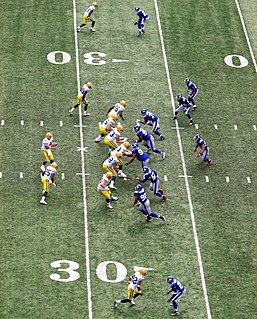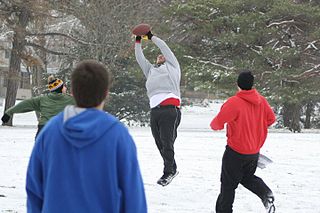
Canadian football is a sport played in Canada in which two teams of 12 players each compete for territorial control of a field of play 110 yards (101 m) long and 65 yards (59 m) wide attempting to advance a pointed oval-shaped ball into the opposing team's scoring area.

The quarterback, colloquially known as the "signal caller", is a position in gridiron football. Quarterbacks are members of the offensive platoon and mostly line up directly behind the offensive line. In modern American football, the quarterback is usually considered the leader of the offense, and is often responsible for calling the play in the huddle. The quarterback also touches the ball on almost every offensive play, and is the offensive player that almost always throws forward passes. When the QB is tackled behind the line of scrimmage, it is called a sack.

The shotgun formation is a formation used by the offensive team in gridiron football mainly for passing plays, although some teams use it as their base formation. Instead of the quarterback receiving the snap from center at the line of scrimmage, in the shotgun he stands farther back, often five to seven yards off the line. Sometimes the quarterback will have a back on one or both sides before the snap, while other times he will be the lone player in the backfield with everyone spread out as receivers.

A running back (RB) is a member of the offensive backfield in gridiron football. The primary roles of a running back are to receive handoffs from the quarterback to rush the ball, to line up as a receiver to catch the ball, and block. There are usually one or two running backs on the field for a given play, depending on the offensive formation. A running back may be a halfback, a wingback or a fullback. A running back will sometimes be called a "feature back" if he is the team's starting running back.

In gridiron football, a lineman is a player who specializes in play at the line of scrimmage. The linemen of the team currently in possession of the ball are the offensive line, while linemen on the opposing team are the defensive line. A number of NFL rules specifically address restrictions and requirements for the offensive line, whose job is to help protect the quarterback from getting sacked for a loss, or worse, fumbling. The defensive line is covered by the same rules that apply to all defensive players. Linemen are usually the largest players on the field in both height and weight, since their positions usually require less running and more strength than skill positions.
A wide receiver (WR), also referred to as a wideout, formerly a split end, is an eligible receiver in gridiron football. A key skill position of the offense, it gets its name from the player being split out "wide", farthest away from the rest of the offensive formation.
A draw play, or simply draw for short, is a type of American football play. The draw is a running play disguised as a passing play. It is the opposite of a play-action pass, which is a passing play disguised as a running play. The play is often used in long yardage situations.

Defensive end (DE) is a defensive position in the sport of gridiron football.

Center (C) is a position in gridiron football. The center is the innermost lineman of the offensive line on a football team's offense. The center is also the player who passes the ball between his legs to the quarterback at the start of each play.

In American football, a T formation is a formation used by the offensive team in which three running backs line up in a row about five yards behind the quarterback, forming the shape of a "T".

A halfback (HB) is an offensive position in American football, whose duties involve lining up in the backfield and carrying the ball on most rushing plays, i.e. a running back. When the principal ball carrier lines up deep in the backfield, and especially when that player is placed behind another player, as in the I formation, that player is instead referred to as a tailback.

In American football, the specific role that a player takes on the field is referred to as their "position." Under the modern rules of American football, both teams are allowed 11 players on the field at one time and have "unlimited free substitutions," meaning that they may change any number of players during any "dead ball" situation. This has resulted in the development of three task-specific "platoons" of players within any single team: the offense, the defense, and the so-called 'special teams'. Within these three separate "platoons", various positions exist depending on the jobs that the players are doing.

Street football, also known as backyard football or sandlot football, is a simplified variant of American football primarily played informally by youth. It features far less equipment and fewer rules than its counterparts, but unlike the similar touch football, features full tackling.
In American football, a play is a close-to-the-ground plan of action or strategy used to move the ball down the field. A play begins at either the snap from the center or at kickoff. Most commonly, plays occur at the snap during a down. These plays range from basic to very intricate. Football players keep a record of these plays in a playbook.

Zone coverage is a defense scheme in gridiron football used to protect against the pass.

In gridiron football, motion refers to the movement of an offensive player at the time of the snap.
The following terms are used in American football, both conventional and indoor. Some of these terms are also in use in Canadian football; for a list of terms unique to that code, see Glossary of Canadian football.
In American football, a smashmouth offense is an offensive system that relies on a strong running game, where most of the plays run by the offense are handoffs to the fullback or tailback. It is a more traditional style of offense that often results in a higher time of possession by running the ball heavily. So-called "smash-mouth football" is often run out of the I-formation or wishbone formation, with tight ends and receivers used as blockers. Though the offense is run-oriented, pass opportunities can develop as defenses play close to the line. Play-action can be very effective for a run-oriented team.
A play calling system in American football is the specific language and methods used to call offensive plays.













